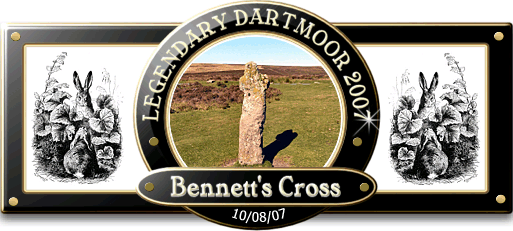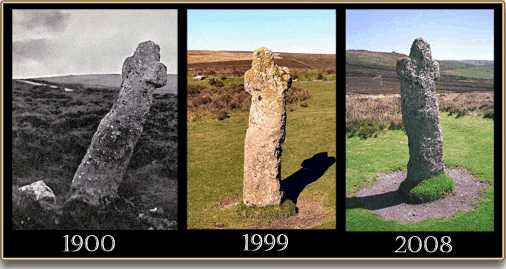
Bennett’s Cross – why, because somebody pinched his pasty! Well hardly, Bennett’s Cross in an ancient, granite wayside cross that sits just beside the B3212 near the Warren House Inn. This particular cross always appears to be in agony, its form somehow resembling a small man twisted up with arthritis. But I suppose if anyone had stood in such an exposed spot for as long as the cross they too would look pretty crooked. William Crossing is less than complimentary when he describes the cross, p.145:
“It stands near the road on the left as we advance, and it will be seen that it is leaning considerably out of perpendicular, but is yet in a perfect condition. It is of very rugged appearance, no pains having been taken in forming the shaft, this seeming to be little more than the stone left in its natural shape, the short, rudely carved arms, and the head, being the only parts in which any attempt at fashioning has been displayed“.
In his book, Crossing includes a photograph from around 1900 which shows the old cross leaning at a gravity defying angle of about 45º, ,although the one from below was taken by T. A. Falcon. As can be seen at least today the cross has been spared the indignity of, “leaning out of perpendicular“. Today the old cross stands proudly erect which in a way emphasises even more the crooked nature of its shaft.

When last measured the cross stood to a height of 1.73m with a shaft circumference of 1.24m. The span of the stumpy arms is a mere 56cm which when compared with other moorland crosses is stumpy to say the least, Sandles, p.10. As with many of Dartmoor’s crosses its age is unknown although Crossing does mention that Bennet’s (sic) cross was mentioned in a tithe dispute document of 1702. Although barely discernable today there is in fact the letters ‘W’ and ‘B’ carved into the western face of the cross. It seems time, the weather, lichens and a lightening strike in 1985 have combined to remove the lettering from sight. The initials stand for ‘Warren Bounds’ and denote that the cross is a point along the bounds of the old, nearby Headland rabbit warren, Brewer, pp. 265-7.
Not only is Bennett’s Cross a boundary marker for Headland Warren it also serves as a boundary marker for the parishes of Chagford and North Bovey. It also stands very close to where the boundary of the Vitifer tin mine was marked by a long gone pile of stones. But Bennett, Bennett, who the hell was Bennett? Sadly nobody knows but Starkey, p.65, notes how there was a 16th century tinner named William Bennet in a stannary record of the time and he held mining rights in the area of the cross. In which case he may well have decided to utilise the cross as one of the limits of his sett, afterall who would dare interfere with such sacred stone? Alternatively, there is a publishers note in Harrison’s book, Dartmoor Stone Crosses, p.246, stating that in the late 1860’s a man called Ellery Bennett found the cross partially buried in the peat and heather and had it cleaned and re-erected where it stands today. As this work was carried out at his personal expense the cross became known as, Bennett’s Cross’. The only thing with this version is that if you look at a photograph of the cross taken by Burnard in 1889 it clearly slopes at the alarming angle that Crossing described in 1892. So either such a bad job was made of its re-erection that around 30 years later it was leaning or the ‘story’ of Ellery Bennett’s rescue is incorrect.
There has been a fair amount of discussion as the the original purpose of the stone cross, some believe that it was set up as an original boundary marker and others consider that as it stands on an old moorland track it was a wayside marker. Another theory currently on the web is that the cross was originally a prehistoric menhir that has been ‘Christianised’ at a later date. To back up this idea it is also noted that the cross stands on a ley line hence the reason for its original erection.
It has been suggested that in recent times there have been attempts made to steal the cross, presumably its location so close to the road made it an attractive target. However, the cross was one of the first of the granite moorland relics to receive a hidden microchip which will aid identification should it ever go walk abouts.

Brewer, D. 2002 Dartmoor Boundary Markers, Halsgrove Publishing, Tiverton.
Crossing, W. 1987 The Ancient Stone Crosses of Dartmoor, Devon Books, Exeter.
Harrison, B. 2001 Dartmoor Stone Crosses, Halsgrove Publishing, Tiverton.
Sandles, T. 1998 A Pilgrimage to Dartmoor’s Stone Crosses, Forest Publishing, Liverton.
Starkey, F. H. 1989 Dartmoor Crosses and some Ancient Tracks, F. H. Starkey, Exeter
 Legendary Dartmoor The many aspects past and present of Dartmoor
Legendary Dartmoor The many aspects past and present of Dartmoor
